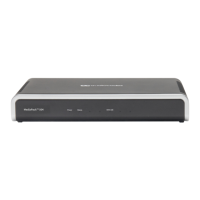SIP User's Manual 234 Document #: LTRT-65415
MediaPack Series
Notes:
• The device is always ready to receive DTMF packets over IP in all
possible transport modes: INFO messages, NOTIFY, and RFC 2833 (in
proper payload type) or as part of the audio stream.
• To exclude RFC 2833 Telephony event parameter from the device's
SDP, set RxDTMFOption to 0 in the ini file.
The following parameters affect the way the device handles the DTMF digits:
TxDTMFOption, RxDTMFOption, and RFC2833PayloadType
MGCPDTMFDetectionPoint, DTMFVolume, DTMFTransportType, DTMFDigitLength,
and DTMFInterDigitInterval
8.2.4 FXS and FXO Capabilities
8.2.4.1 FXS/FXO Coefficient Types
The FXS Coefficient and FXO Coefficient types used by the device can be one of the
following:
US line type of 600 ohm AC impedance and 40 V RMS ringing voltage for REN = 2
European standard (TBR21)
These types can be selected using the ini file parameters FXSCountryCoefficients (for
FXS) and CountryCoefficients (for FXO), or using the Web interface (see ''Configuring
Analog Settings'' on page 101).
These Co
efficient types are used to increase return loss and trans-hybrid loss performance
for two telephony line type interfaces (US or European). This adaptation is performed by
modifying the telephony interface characteristics. This means, for example, that changing
impedance matching or hybrid balance doesn't require hardware modifications, so that a
single device is able to meet requirements for different markets. The digital design of the
filters and gain stages also ensures high reliability, no drifts (over temperature or time) and
simple variations between different line types.
The FXS Coefficient types provide best termination and transmission quality adaptation for
two FXS line type interfaces. This parameter affects the following AC and DC interface
parameters:
DC (battery) feed characteristics
AC impedance matching
Transmit gain
Receive gain
Hybrid balance
Frequency response in transmit and receive direction
Hook thresholds
Ringing generation and detection parameters
8.2.4.2 FXO Operating Modes
This section provides a description of the device's FXO operating modes:
For IP-to-Tel calls (see ''FXO Operations for IP-to-Tel Calls'' on page 235)
For Tel
-to-IP calls (see ''FXO Operations for Tel-to-IP Calls'' on page 238)
Call termi
nation on FXO devices (see ''Call Termination on FXO Devices'' on page
240)

